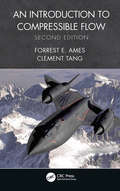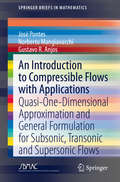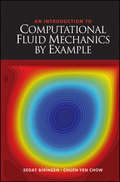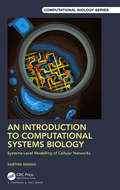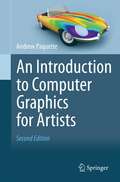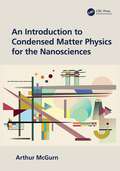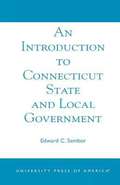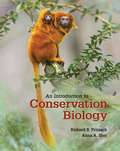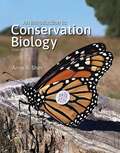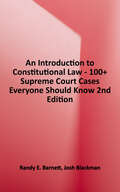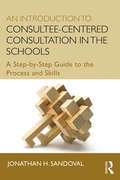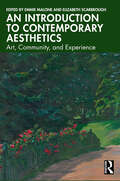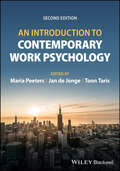- Table View
- List View
An Introduction to Complex Systems: Society, Ecology, and Nonlinear Dynamics
by Paul FieguthComplex Systems lie at the heart of a variety of large-scale phenomena of great significance - global warming, ice ages, water, poverty, pandemics - and this text uses these case studies as motivations and contexts to explore complex systems and related topics of nonlinear dynamics and power-law statistics. Although detailed mathematical descriptions of these topics can be challenging, the consequences of a system being nonlinear, power-law, or complex are in fact quite accessible. This book blends a tutorial approach to the mathematical aspects of complex systems together with a complementary narrative on the global/ecological/societal implications of such systems. Nearly all engineering undergraduate courses focus on mathematics and systems which are small scale, linear, and Gaussian. Unfortunately there is not a single large-scale ecological or social phenomenon that is scalar, linear, and Gaussian. This book offers insights to better understand the large-scale problems facing the world and to realize that these cannot be solved by a single, narrow academic field or perspective. Instead, the book seeks to emphasize understanding, concepts, and ideas, in a way that is mathematically rigorous, so that the concepts do not feel vague, but not so technical that the mathematics get in the way. The book is intended for students in technical domains such as engineering, computer science, physics, mathematics, and environmental studies. This second edition adds nine new examples, over 30 additional problems, 50 additional figures, and three new chapters offering a detailed study of system decoupling, extensive solutions to chapter problems, and a timely discussion on the complex systems challenges associated with COVID-19 and pandemics in general.
An Introduction to Composite Materials
by D. Hull T. W. ClyneThis new edition has been greatly enlarged and updated to provide both scientists and engineers with a clear and comprehensive understanding of composite materials. In describing both theoretical and practical aspects of their production, properties and usage, the book crosses the borders of many disciplines. Topics covered include: fibers, matrices, laminates and interfaces; elastic deformation, stress and strain, strength, fatigue crack propagation and creep resistance; toughness and thermal properties; fatigue and deterioration under environmental conditions; fabrication and applications. Coverage has been increased to include polymeric, metallic and ceramic matrices and reinforcement in the form of long fibers, short fibers and particles. Designed primarily as a teaching text for final year undergraduates in materials science and engineering, this book will also interest undergraduates and postgraduates in chemistry, physics, and mechanical engineering. In addition, it will be an excellent source book for academic and technological researchers on materials.
An Introduction to Composite Materials (Cambridge Solid State Science Ser.)
by D. Hull T. W. ClyneThis fully expanded and updated edition provides both scientists and engineers with all the information they need to understand composite materials, covering their underlying science and technological usage. It includes four completely new chapters on surface coatings, highly porous materials, bio-composites and nano-composites, as well as thoroughly revised chapters on fibres and matrices, the design, fabrication and production of composites, mechanical and thermal properties, and industry applications. Extensively expanded referencing engages readers with the latest research and industrial developments in the field, and increased coverage of essential background science makes this a valuable self-contained text. A comprehensive set of homework questions, with model answers available online, explains how calculations associated with the properties of composite materials should be tackled, and educational software accompanying the book is available online. An invaluable text for final-year undergraduates in materials science and engineering, and graduate students and researchers in academia and industry.
An Introduction to Compressible Flow
by Forrest E. Ames Clement C. TangAn Introduction to Compressible Flow, Second Edition covers the material typical of a single-semester course in compressible flow. The book begins with a brief review of thermodynamics and control volume fluid dynamics, then proceeds to cover isentropic flow, normal shock waves, shock tubes, oblique shock waves, Prandtl-Meyer expansion fans, Fanno-line flow, Rayleigh-line flow, and conical shock waves. The book includes a chapter on linearized flow following chapters on oblique shocks and Prandtl-Meyer flows to appropriately ground students in this approximate method. It includes detailed appendices to support problem solutions and covers new oblique shock tables, which allow for quick and accurate solutions of flows with concave corners. The book is intended for senior undergraduate engineering students studying thermal-fluids and practicing engineers in the areas of aerospace or energy conversion. This book is also useful in providing supplemental coverage of compressible flow material in gas turbine and aerodynamics courses.
An Introduction to Compressible Flows with Applications: Quasi-One-Dimensional Approximation and General Formulation for Subsonic, Transonic and Supersonic Flows (SpringerBriefs in Mathematics)
by José Pontes Norberto Mangiavacchi Gustavo R. AnjosThis book offers a concise and practical survey of the principles governing compressible flows, along with selected applications.It starts with derivation of the time-dependent, three-dimensional equation of compressible potential flows, and a study of weak waves, including evaluation of the sound speed in gases. The following chapter addresses quasi-one-dimensional flows, the study of normal shock waves, and flow in ducts with constant cross section subjected to friction and/or heat transfer. It also investigates the effects of friction and heat transfer in ducts with variable cross section. The chapter ends by pointing to the analogy between one-dimensional compressible flows and open channel hydraulics.Further, the book discusses supersonic flows, including the study of oblique shock waves, and supersonic flows over corners and wedges. It also examines Riemann problems, numerical resolution of the wave equation, and of nonlinear hyperbolic problems, including propagation of strong waves. A subsequent chapter focuses on the small perturbation theory of subsonic, transonic and supersonic flows around slender bodies aligned or almost aligned to the uniform inflow. In particular, it explores subsonic and supersonic flows over a wavy wall. Lastly, an appendix with a short derivation of the Fluid Mechanics basic equations is included.The final chapter addresses the problem of transonic flows where both subsonic and supersonic are present. Lastly, an appendix with a short derivation of the Fluid Mechanics basic equations is included.Illustrated with several practical examples, this book is a valuable tool to understand the most fundamental mathematical principles of compressible flows. Graduate Mathematics, Physics and Engineering students as well as researchers with an interest in the aerospace sciences benefit from this work.
An Introduction to Computational Fluid Mechanics by Example
by Chuen-Yen Chow Sedat BiringenThis new book builds on the original classic textbook entitled: An Introduction to Computational Fluid Mechanics by C. Y. Chow which was originally published in 1979. In the decades that have passed since this book was published the field of computational fluid dynamics has seen a number of changes in both the sophistication of the algorithms used but also advances in the computer hardware and software available. This new book incorporates the latest algorithms in the solution techniques and supports this by using numerous examples of applications to a broad range of industries from mechanical and aerospace disciplines to civil and the biosciences. The computer programs are developed and available in MATLAB. In addition the core text provides up-to-date solution methods for the Navier-Stokes equations, including fractional step time-advancement, and pseudo-spectral methods. The computer codes at the following website: www.wiley.com/go/biringen
An Introduction to Computational Science (International Series in Operations Research & Management Science #278)
by Allen Holder Joseph EichholzThis textbook provides an introduction to the growing interdisciplinary field of computational science. It combines a foundational development of numerical methods with a variety of illustrative applications spread across numerous areas of science and engineering. The intended audience is the undergraduate who has completed introductory coursework in mathematics and computer science. Students gain computational acuity by authoring their own numerical routines and by practicing with numerical methods as they solve computational models. This education encourages students to learn the importance of answering: How expensive is a calculation, how trustworthy is a calculation, and how might we model a problem to apply a desired numerical method?The text is written in two parts. Part I provides a succinct, one-term inauguration into the primary routines on which a further study of computational science rests. The material is organized so that the transition to computational science from coursework in calculus, differential equations, and linear algebra is natural. Beyond the mathematical and computational content of Part I, students gain proficiency with elemental programming constructs and visualization, which are presented in MATLAB syntax. The focus of Part II is modeling, wherein students build computational models, compute solutions, and report their findings. The models purposely intersect numerous areas of science and engineering to demonstrate the pervasive role played by computational science.
An Introduction to Computational Stochastic PDEs
by Gabriel J. Lord Catherine E. Powell Tony ShardlowThis book gives a comprehensive introduction to numerical methods and analysis of stochastic processes, random fields and stochastic differential equations, and offers graduate students and researchers powerful tools for understanding uncertainty quantification for risk analysis. Coverage includes traditional stochastic ODEs with white noise forcing, strong and weak approximation, and the multi-level Monte Carlo method. Later chapters apply the theory of random fields to the numerical solution of elliptic PDEs with correlated random data, discuss the Monte Carlo method, and introduce stochastic Galerkin finite-element methods. Finally, stochastic parabolic PDEs are developed. Assuming little previous exposure to probability and statistics, theory is developed in tandem with state-of the art computational methods through worked examples, exercises, theorems and proofs. The set of MATLAB codes included (and downloadable) allows readers to perform computations themselves and solve the test problems discussed. Practical examples are drawn from finance, mathematical biology, neuroscience, fluid flow modeling and materials science.
An Introduction to Computational Systems Biology: Systems-Level Modelling of Cellular Networks (Chapman & Hall/CRC Computational Biology Series)
by Karthik Raman"This is a very comprehensive read that provides a solid base in computational biology. The book is structured in 4 parts and 14 chapters which cover all the way from the more basic concepts to advanced material, including the state-of-the-art methodologies in synthetic and systems biology. This is a bedside book for those researchers embarking to do investigation in computational biology and a great office companion for anyone working on systems and synthetic biology." -- Rodrigo Ledesma Amaro, Lecturer, Imperial College London "This is a fantastic book. It offers an elegant introduction to both classical and modern concepts in computational biology. To the uninitiated, it is a terrific first read, bringing alive the glory of the past and the promise of the future. To the interested, it handholds and offers a springboard to dive deep. To the practitioner, it serves as a valuable resource bringing together in a panoramic view many diverse streams that adorn the landscape." -- Narendra M. Dixit, Professor, Indian Institute of Science An Introduction to Computational Systems Biology: Systems-Level Modelling of Cellular Networks delivers a comprehensive and insightful account of applying mathematical modelling approaches to very large biological systems and networks—a fundamental aspect of computational systems biology. The book covers key modelling paradigms in detail, while at the same time retaining a simplicity that will appeal to those from less quantitative fields. Features A hands-on approach to modelling Covers a broad spectrum of modelling, from static networks to dynamic models and constraint-based models Thoughtful exercises to test and enable understanding of concepts State-of-the-art chapters on exciting new developments like community modelling and biological circuit design Emphasis on coding and software tools for systems biology This book is highly multi-disciplinary and will appeal to biologists, engineers, computer scientists, mathematicians and others.
An Introduction to Computer Graphics for Artists
by Andrew PaquetteAn Introduction to Computer Graphics for Artists is an application-independent, reader-friendly primer for anyone with a serious desire to understand 3D Computer Graphics. Written by a veteran of the computer graphics industry whose previous career included film animation and various spells as Art Director for video games, Andrew Paquette draws on his experiences both as an artist and a manager. Far too often artists, even professionals, lack a basic understanding of the principles of computer graphics. The result is inefficiency and lower quality of work. This book addresses these issues by providing fundamental information in a university course format, with theoretical material, detailed illustrations, and projects to test the reader's understanding of the concepts covered. Opening with the first and most basic elements of computer graphics, the book rapidly advances into progressively more complex concepts. Each of the elements, however simple, are important to understand because each is an essential link in a chain that allows an artist to master any computer graphics application. With this accomplished, the artist can use technology to satisfy his goals, instead of the technology being master of the artist. All students wanting to learn more about computer graphics from an artistic viewpoint, particularly those intending to pursue a career in computer game design or film animation, will find this book invaluable.
An Introduction to Computing with Fuzzy Sets: Analysis, Design, and Applications (Intelligent Systems Reference Library #190)
by Witold PedryczThis book provides concise yet thorough coverage of the fundamentals and technology of fuzzy sets. Readers will find a lucid and systematic introduction to the essential concepts of fuzzy set-based information granules, their processing and detailed algorithms. Timely topics and recent advances in fuzzy modeling and its principles, neurocomputing, fuzzy set estimation, granulation–degranulation, and fuzzy sets of higher type and order are discussed. In turn, a wealth of examples, case studies, problems and motivating arguments, spread throughout the text and linked with various areas of artificial intelligence, will help readers acquire a solid working knowledge. Given the book’s well-balanced combination of the theory and applied facets of fuzzy sets, it will appeal to a broad readership in both academe and industry. It is also ideally suited as a textbook for graduate and undergraduate students in science, engineering, and operations research.
An Introduction to Condensed Matter Physics for the Nanosciences
by Arthur McGurnThe book provides an accessible introduction to the principles of condensed matter physics with a focus on the nanosciences and device technologies. The basics of electronic, phononic, photonic, superconducting, optics, quantum optics, and magnetic properties are explored, and nanoscience and device materials are incorporated throughout the chapters. Many examples of the fundamental principles of condensed matter physics are taken directly from nanoscience and device applications. This book requires a background in electrodynamics, quantum mechanics, and statistical mechanics at the undergraduate level. It will be a valuable reference for advanced undergraduates and graduate students of physics, engineering, and applied mathematics. Features Contains discussions of the basic principles of quantum optics and its importance to lasers, quantum information, and quantum computation. Provides references and a further reading list to additional scientific literature so that readers can use the book as a starting point to then follow up with a more advanced treatment of the topics covered. Requires only a basic background in undergraduate electrodynamics, quantum mechanics, and statistical mechanics.
An Introduction to Connecticut State and Local Government
by Edward C. SemborThis is a comprehensive text for political science courses focused on state and local government.Included are discussions on the governor, General Assembly, the judicial branch, political parties, interest groups and elections.
An Introduction to Conservation Biology
by Richard Primack Anna Sher<p>This is a book well suited for a wide range of undergraduate courses, as both a primary text for conservation biology courses and a supplement for ecological and environmental science courses. <p>New coauthor Anna Sher joins longtime Sinauer author Richard Primack in creating a book that combines the readability of Primack's A Primer of Conservation Biology with the depth and coverage of his larger textbook, Essentials of Conservation Biology. The result is a book well suited for a wide range of undergraduate courses, as both a primary text for conservation biology courses and a supplement for ecological and environmental science courses. <p>Using the chapter framework of the current Primer as a springboard, the authors have added three chapters focused on population biology conservation tools (Chapter 7), restoration ecology (Chapter 10), and the future of conservation (Chapter 12). Sustainable development, ex situ conservation, and other key topics have been expanded and updated with hundreds of new examples, explanations, citations, and figures to enhance learning and excitement for the subject. Dr. Sher has mined her experience of having taught conservation biology using Dr. Primack's texts for over a decade to fine-tune the presentation of difficult concepts, particularly in economics and politics. Coverage of recent conservation biology events in the news—such as the poaching of Cecil the Lion, the first papal encyclical on the environment, and the international Paris Accord on climate change—keeps the content fresh and current.</p>
An Introduction to Conservation Biology
by Anna SherAn Introduction to Conservation Biology is the only text designed for both aspiring conservation biologists and non-majors who are interested in this topical field, providing up-to-date perspectives on high-profile issues such as sustainable development, global warming, and strategies to save species on the verge of extinction. The book focuses successively on biological diversity and its value; threats to biological diversity; conservation at the population and species levels; protecting, managing and restoring ecosystems; and sustainable development. Each chapter is beautifully illustrated in full color with diverse examples from the current literature. Chapters begin with guiding conservation biology principles and end with study aids such as summaries, an annotated list of suggested readings, and discussion questions. Throughout, the authors maintain a focus on the active role that scientists, local people, conservation organizations, government, and the general public play in protecting biodiversity, even while providing for human needs.
An Introduction to Constitutional Law: 100+ Supreme Court Cases Everyone Should Know, 2nd Edition
by Randy E. Barnett Josh BlackmanThis multimedia platform has innovated how constitutional law is studied: incisive and balanced summaries of landmark decisions, written by leading constitutional law scholars, combined with an engaging video library, in an affordable paperback edition. An Introduction to Constitutional Law has been read by tens of thousands of students in law schools, universities, high schools, and homeschools, as well as by people with a general interest in the Supreme Court. An Introduction to Constitutional Law will teach you the narrative of constitutional law as it has developed over the past two centuries. The online video library will bring to life the Supreme Court's 100+ most important decisions. The videos are enriched by photographs, maps, and even audio from the Supreme Court. The Second Edition includes recent Supreme Court cases on abortion, the Second Amendment, and the Free Exercise of Religion, as well as some classic cases on the Freedom of Speech, Criminal Procedure, and Voting Rights. All students—even those unfamiliar with American history—will learn the essential background information to grasp how this body of law has come to be what it is today.
An Introduction to Consultee-Centered Consultation in the Schools: A Step-by-Step Guide to the Process and Skills (Consultation, Supervision, and Professional Learning in School Psychology Series)
by Jonathan H. SandovalDrawing on historical writings about mental health consultation and on contemporary research and theory, Jonathan Sandoval lucidly explains the consultee-centered approach to consultation. The book provides an expert foundation on which to build a training program for future school-based consultants. Written for graduate students in school psychology, counseling psychology, special education, and social work, this book is an invaluable resource for mental health professionals working in schools who wish to upgrade their professional skills and grow as reflective practitioners. Individual chapters describe different stages in the consultation process; outline the processes characterized in each stage; detail useful consultant skills; review pertinent research; discuss the ethical principles underlying practice; and suggest self-monitoring questions for student consultants. Featuring a step-by-step developmental model of the consultee-centered consultation process, this book encourages consultants to prioritize those characteristics that contribute to a consultee’s work difficulty, in addition to assessing the client more generally. By detailing this unique approach, this concise volume provides an applicable, contextualized, and strategic form of consultation, and fosters a professional-to-professional relationship distinguishable from supervision, counseling, therapy, coaching or other methods.
An Introduction to Contemporary Aesthetics: Art, Community, and Experience
by Emmie Malone Elizabeth ScarbroughAn Introduction to Contemporary Aesthetics: Art, Community, and Experience gives students and other readers a comprehensive sense of the dynamic issues and problems in aesthetics and philosophy of art today. Each of the 14 chapters is written by a different expert in the field, and together they cover a wide range of methodological approaches and perspectives, including those from analytic and Continental philosophy, non-Eurocentric global traditions, and critical stances taken up by feminist philosophers and philosophers of race. In addition, the volume makes use of recent empirical work on art and beauty as well as examples of artistic expressions from cultures from around the world. In contrast to other coursebooks, which are often structured entirely around artforms, this volume frames much of its contents around core aesthetic concepts—like good or bad taste, interpretation, or authenticity—with each chapter devoted to a different concept. Within each chapter, the reader will find a range of engaging artforms and experiences. The contents of the volume are laid out in four parts: the first focuses on foundational questions in aesthetics and the second on key aesthetic concepts. The third part focuses on applied questions relating to particular artforms and genres (e.g., horror, comedy, AI art, games). Finally, the last part of the volume takes a wider, but still practical, view, focusing on why aesthetic life matters to us, both as a society and as individuals.Key Features Written in a non-technical style for readers new to aesthetics and with little or no background in philosophy or the study of the arts Draws on examples readers encounter in everyday life and popular culture, from Drake to Philly cheesesteaks Deals with questions that concern many college students today: Does authenticity even matter and, if so, why? What’s wrong with enjoying the work of an immoral artist? How are our homes and schools important places of aesthetic meaning? Each chapter is written as a biased survey, with clear coverage of the historical and contemporary literature on the topic but also from a distinct, subjective point of view Non-Eurocentric philosophies or examples are included throughout the book, highlighting the rich and diverse philosophical work from around the globe Discussion Questions offer student readers opportunities to engage more fully with the problems raised in the text Suggestions for Further Reading at the end of each chapter identify the most promising avenues for further research on the topic
An Introduction to Contemporary Work Psychology
by Jan De Jonge Maria C.W. Peeters Toon W. TarisThis is the first comprehensive overview of work psychology, with coverage of classic models, current theories, and contemporary issues affecting the 21st-century worker. Examines the positive aspects of work-motivation, performance, creativity, and engagement--instead of focusing only on adverse effectsEdited by leaders in the field with chapters written by a global team of experts from the US, UK, Europe, and AustraliaDiscusses topics such as safety at work, technology, working times, work-family interaction, working in teams , recovery, job demands and job resources, and sickness absenceSuitable for advanced courses focused on work psychology as a sub discipline of work and organizational psychologyDidactic features include questions for discussion, boxes with practical applications, further reading sections, and a glossary
An Introduction to Contemporary Work Psychology
by Jan De Jonge Maria C. W. Peeters Toon TarisAN INTRODUCTION TO CONTEMPORARY WORK PSYCHOLOGY A fully updated edition of the definitive textbook Work psychology is the study of work behavior and the psychological dimensions that both produce and result from it. It has developed in recent decades into a field that takes a comprehensive view of 21st century workers and their psychological context and condition. Now fully updated to reflect the latest research and practical insights, it promises to continue as an indispensable resource for advanced courses in work psychology. Readers of the second edition of An Introduction to Contemporary Work Psychology will find: Chapters written by a global team of experts Overview of classic and current theories that comprise Work Psychology Detailed discussion of topics such as leadership, emotion work, sustainable careers, job crafting and the future of work A unique focus on positive aspects of work, including motivation, engagement, personal resources and positive workplace interventions An Introduction to Contemporary Work Psychology is ideal for advanced undergraduate and graduate students enrolled in work psychology courses, as well as for students or researchers looking for a reference or introduction to the subject. “Understanding work from various psychological perspectives has become highly relevant for all those involved and interested in the diverse and changing nature of work-life. This book is a treasury of what is important to know of current work psychology. It is timely, comprehensive, and enjoyable reading. Editors and authors have done great job and now it is time for readers to enjoy this book and its many perspectives to the world of contemporary work and organizational psychology.” —Jari Hakanen, PhD, Research professor, Finnish Institute of Occupational Health
An Introduction to Continuous-Time Stochastic Processes: Theory, Models, and Applications to Finance, Biology, and Medicine (Modeling and Simulation in Science, Engineering and Technology)
by Vincenzo Capasso David BaksteinThis textbook, now in its third edition, offers a rigorous and self-contained introduction to the theory of continuous-time stochastic processes, stochastic integrals, and stochastic differential equations. Expertly balancing theory and applications, the work features concrete examples of modeling real-world problems from biology, medicine, industrial applications, finance, and insurance using stochastic methods. No previous knowledge of stochastic processes is required. Key topics include:Markov processesStochastic differential equationsArbitrage-free markets and financial derivativesInsurance riskPopulation dynamics, and epidemicsAgent-based modelsNew to the Third Edition:Infinitely divisible distributionsRandom measuresLevy processesFractional Brownian motionErgodic theoryKarhunen-Loeve expansionAdditional applicationsAdditional exercisesSmoluchowski approximation of Langevin systemsAn Introduction to Continuous-Time Stochastic Processes, Third Edition will be of interest to a broad audience of students, pure and applied mathematicians, and researchers and practitioners in mathematical finance, biomathematics, biotechnology, and engineering. Suitable as a textbook for graduate or undergraduate courses, as well as European Masters courses (according to the two-year-long second cycle of the "Bologna Scheme"), the work may also be used for self-study or as a reference. Prerequisites include knowledge of calculus and some analysis; exposure to probability would be helpful but not required since the necessary fundamentals of measure and integration are provided. From reviews of previous editions:"The book is . . . an account of fundamental concepts as they appear in relevant modern applications and literature. . . . The book addresses three main groups: first, mathematicians working in a different field; second, other scientists and professionals from a business or academic background; third, graduate or advanced undergraduate students of a quantitative subject related to stochastic theory and/or applications. " -Zentralblatt MATH
An Introduction to Continuous-Time Stochastic Processes: Theory, Models, and Applications to Finance, Biology, and Medicine (Modeling and Simulation in Science, Engineering and Technology)
by Vincenzo Capasso David BaksteinThis textbook, now in its fourth edition, offers a rigorous and self-contained introduction to the theory of continuous-time stochastic processes, stochastic integrals, and stochastic differential equations. Expertly balancing theory and applications, it features concrete examples of modeling real-world problems from biology, medicine, finance, and insurance using stochastic methods. No previous knowledge of stochastic processes is required. Unlike other books on stochastic methods that specialize in a specific field of applications, this volume examines the ways in which similar stochastic methods can be applied across different fields.Beginning with the fundamentals of probability, the authors go on to introduce the theory of stochastic processes, the Itô Integral, and stochastic differential equations. The following chapters then explore stability, stationarity, and ergodicity. The second half of the book is dedicated to applications to a variety of fields, including finance, biology, and medicine. Some highlights of this fourth edition include a more rigorous introduction to Gaussian white noise, additional material on the stability of stochastic semigroups used in models of population dynamics and epidemic systems, and the expansion of methods of analysis of one-dimensional stochastic differential equations.An Introduction to Continuous-Time Stochastic Processes, Fourth Edition is intended for graduate students taking an introductory course on stochastic processes, applied probability, stochastic calculus, mathematical finance, or mathematical biology. Prerequisites include knowledge of calculus and some analysis; exposure to probability would be helpful but not required since the necessary fundamentals of measure and integration are provided. Researchers and practitioners in mathematical finance, biomathematics, biotechnology, and engineering will also find this volume to be of interest, particularly the applications explored in the second half of the book.
An Introduction to Continuum Mechanics
by J. N. ReddyThis textbook reflects the modern view that scientists and engineers should be trained to think and work in multidisciplinary environments. Topics include derivations of the basic equations of invariant (vector and tensor) and form and specializations of the governing equations to various coordinate systems.
An Introduction to Continuum Mechanics, Second Edition
by J. N. ReddyThis best-selling textbook presents the concepts of continuum mechanics in a simple yet rigorous manner. The book introduces the invariant form as well as the component form of the basic equations and their applications to problems in elasticity, fluid mechanics, and heat transfer, and offers a brief introduction to linear viscoelasticity. The book is ideal for advanced undergraduates and beginning graduate students looking to gain a strong background in the basic principles common to all major engineering fields, and for those who will pursue further work in fluid dynamics, elasticity, plates and shells, viscoelasticity, plasticity, and interdisciplinary areas such as geomechanics, biomechanics, mechanobiology, and nanoscience. The book features derivations of the basic equations of mechanics in invariant (vector and tensor) form and specification of the governing equations to various coordinate systems, and numerous illustrative examples, chapter summaries, and exercise problems. This second edition includes additional explanations, examples, and problems.
An Introduction to Coping with Anxiety, 2nd Edition
by Brenda Hogan Leonora BrosanOvercoming app now available via iTunes and the Google Play Store.Anxiety is one of the most common mental health conditions worldwide, affecting millions of people each year. But it can be treated effectively with cognitive behavioural therapy (CBT).Written by experienced practitioners, this introductory book can help you if anxiety has become a problem. It explains what anxiety is and how it makes you feel when it becomes unmanageable or lasts for long periods of time. It will help you to understand your symptoms and is ideal as an immediate coping strategy and as a preliminary to fuller therapy. You will learn:· What anxiety is and how it develops· Physical symptoms to look out for· How to spot and challenge thoughts that make you anxious· Ways to change how you behave in order to reduce your feelings of anxiety



